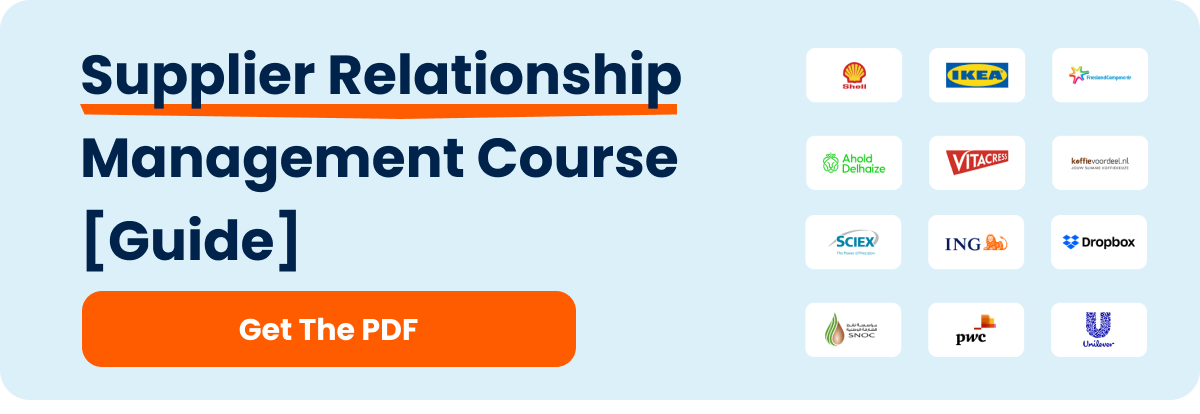Written by Marijn Overvest | Reviewed by Sjoerd Goedhart | Fact Checked by Ruud Emonds | Our editorial policy
Vendor Managed Inventory — Explained + Example

As taught in the Supplier Relationship Management Course / ★★★★★ 4.9 rating
What is vendor-managed inventory (VMI)?
- VMI is a supply chain model in which the supplier monitors and replenishes inventory at the customer’s site to maintain agreed stock levels.
- VMI shifts the responsibility for ordering and stocking products to the vendor, using real-time sales and inventory data.
- VMI optimizes inventory levels and reduces stockouts by enabling suppliers to proactively manage replenishment.

Vendor Managed Inventory: What is it?
Vendor Managed Inventory (VMI) refers to the approach where suppliers handle a retailer’s inventory for them. They make decisions and keep restocking the products continuously. To make VMI work, there’s a way for suppliers to get the retailer’s sales and inventory data, like through the Internet. This data helps suppliers know what to stock and when to order more. Traditionally, the retailer does all of this.
With VMI, the supplier and retailer share inventory data automatically. This makes the supply chain work better and match the actual demand. It helps to predict what’s needed, send products at the right time, and keep enough stock in stores. This way, they can quickly adapt to what customers want.
Furthermore, vendors may use special software to plan when to ship and produce goods called Vendor Management Inventory System (VMIS). Utilizing a vendor management system allows the vendor to handle and restock inventory at the customer’s location based on their specific needs. Customers share important data like sales, inventory levels, targets, and forecasts with the vendor using EDI (Electronic Data Interchange). The vendor then creates a detailed plan customized for each customer.
VMI is a fantastic tool for businesses using it, as it offers benefits like quicker lead times, better transportation planning, improved customer experience, and more efficient operations.
Vendor Managed Inventory – Examples
Vendor-Managed Inventory (VMI) works best when the supplier and the customer share near-real-time demand data and trust the numbers enough to let the supplier replenish stock proactively. Below you’ll find the same five headline examples, now enriched with concrete data points and proof-of-performance you can cite in a presentation or report.
1. P&G + Walmart
P&G pioneered “Continuous Replenishment” with Walmart in the late 1980s. Using point-of-sale feeds from Walmart’s Retail Link, P&G’s planners adjust factory output and ship mixed truckloads that go straight to the retailer’s regional DCs.
Real-world example:
Academic reviews of the program show that Walmart cut its diaper inventory by roughly 30 percent while trimming out-of-stocks by about 10 percent, freeing DC space and working capital, yet keeping shelf availability above 98 percent.
2. Coca-Cola & Bottling Partners
Coca-Cola’s decentralized bottling network (225 independent bottlers, 900+ plants worldwide) relies on VMI signals pushed through the Coke One North America (CONA) and other ERP hubs. Bottlers get daily sales and inventory files from retailers, then adjust syrup blending, bottle blowing, and transport schedules in near real time.
Real-world example:
RFgen’s profile of the Coca-Cola supply chain notes that this tight data loop lets local plants replenish store shelves within hours, maintaining 95 percent+ service levels even during high-volume events such as the Super Bowl or FIFA World Cup promotions.
3. Toyota & Tier-1 Suppliers (e.g., Denso)
Kanban cards plus EDI feeds form Toyota’s classic VMI setup. Tier-1 suppliers such as Denso own the inventory on Toyota’s plant floor and trigger replenishment when bins are empty.
Real-world example:
Denso keeps, on average, just 0.8 days of finished-goods inventory for Toyota—half the buffer it must hold for automakers with less stable demand—while still meeting every takt-time pull signal on the line.
4. Dell & Component Hubs
Dell’s build-to-order PC model depends on VMI hubs stationed minutes from assembly plants in Austin and Xiamen. Suppliers retain ownership of CPUs, drives, and memory modules until Dell scans them into a customer order.
Real-world example:
The switch from forecast build to VMI-enabled build-to-order slashed total inventory from 70+ days to about 7 days, lifted inventory turns above 60 per year, and helped revenue rocket from USD 389 million (1990) to USD 25 billion (2000).
5. W.W. Grainger (KeepStock®)
Grainger’s KeepStock program installs RFID-labeled shelves or vending machines at customer sites. Usage data flows to Grainger, which refills PPE, MRO, and spare parts automatically.
Real-world example:
Internal case studies report spending cuts of up to 25 percent on indirect materials, with KeepStock customers growing twice as fast as non-KeepStock accounts and stock-outs dropping by 10-25 percent.
How Does Vendor Managed Inventory Work?
Now that you know what Vendor Managed Inventory (VMI) is, let’s explore how it works.
Step 1: Define the VMI Agreement
Every successful VMI program starts with a clear, written agreement. In this document, the buyer and the vendor spell out service-level targets (for example, “98 % on-shelf availability”), ownership transfer points, payment timing, and rules for handling excess or obsolete stock. By allocating risks and responsibilities up front, both parties know exactly what is expected before a single data file is exchanged or a shipment leaves the dock.
Step 2: Connect Data and Metrics
Next, the partners link their systems so that point-of-sale or usage data, on-hand inventory balances, lead-time files, and promotion calendars can flow automatically from the buyer to the vendor. This is usually done through EDI, APIs, or a shared web portal, and it is accompanied by an agreed KPI dashboard. Real-time visibility into demand and inventory becomes the lifeblood of every forecast and replenishment decision that follows.
Step 3: Continuous Demand Monitoring
Once the data pipes are open, the vendor’s planners watch daily sales velocity and stock levels at each customer location. Their goal is to spot fast movers, slow movers, and any unusual demand spikes as early as possible. This constant monitoring gives the vendor a head start in reacting to promotions, seasonality, or supply disruptions.
Step 4: Forecast and Replenishment Calculation
Using the live data, the vendor’s VMI software (or an in-house algorithm) calculates when and how much to replenish. Parameters such as minimum/maximum levels, days-of-coverage targets, safety stock, and lead times are applied to generate a suggested order for each SKU–location pair. In effect, the system converts raw consumption signals into a forward-looking production and shipment plan.
Step 5: Specialist Review and Order Approval
Before an order is released, a VMI analyst reviews the system’s recommendation. The analyst double-checks against upcoming promotions, plant capacity, transit constraints, or any unusual events that the algorithm might not “see.” This human layer of scrutiny prevents costly auto-errors and ensures that every replenishment decision still makes sense in the real world.
Step 6: Ship and Deliver Inventory
After approval, the vendor ships the required goods, often as mixed pallets or full truckloads, to the buyer’s distribution center or store. An advance ship notice (ASN) accompanies the load so the receiving team can plan labor and space. Predictable transit times and traceability at this stage are essential for keeping shelf availability high.
Step 7: Receipt, Ownership, and Payment
The buyer receives the shipment, scans it into inventory, and, depending on the contract, either takes ownership immediately or only when the stock is consumed. Payment follows the agreed financial terms, which might be based on receipt, consumption, or a consignment schedule. This step finalizes the physical and financial hand-off of goods.
Step 8: Performance Review and Continuous Improvement
Finally, a joint VMI steering team meets monthly or quarterly to review key metrics such as fill rate, inventory turns, stock-outs, and excess levels. Any gaps trigger parameter tweaks, process changes, or system enhancements. This continuous-improvement loop keeps the program aligned with shifting demand patterns and drives ongoing savings and service gains for both sides.
The Three Core Pillars of a VMI System
Vendor managed inventory (VMI) stands out from other inventory methods because of three key qualities. The following characteristics define what makes a VMI system special and different:
1. Vendor-controlled reordering and stock keeping
Vendor Managed Inventory (VMI) simplifies inventory management for businesses. With VMI, the vendor takes charge of reordering and stock-keeping tasks, saving companies time and effort. The vendor ensures the right amount of stock is available, reducing the burden on the buyer.
2. Vendor-controlled inventory management
In regular inventory management, business owners have control over their products. But in a VMI system, vendors take charge of inventory. They keep track of where products are in the supply chain and decide when to reorder them. It’s the vendors’ responsibility, not the business owners.
3. Business and vendor information sharing
In a VMI system, maintaining the right inventory levels involves sharing a lot of information between the business and its vendor. This means giving suppliers access to inventory counts at customer locations and sharing customer demand data. This helps the vendor plan their manufacturing effectively.
Limitations of Vendor Managed Inventory
The following are some of the limitations that many vendors commonly face in VMI:
1. Dealing with unreliable partners
When a business uses VMI, the vendor becomes responsible for delivering inventory on time and in the right amounts. However, some suppliers may lack expertise, proper infrastructure, or the right software, leading to supply chain disruptions.
2. Challenges in supplier delivery
In a VMI system, dishonest vendors might send excessive inventory to boost their sales figures. Customers may face difficulties returning the surplus stock, causing inconvenience.
3. Losing control
With VMI, businesses give up control of inventory and rely entirely on the vendor. This might be challenging for some businesses who find it hard to trust a third party with their data and decision-making.
4. Adapting to customer preferences
Customer preferences can change rapidly, affecting business success. VMI contracts should account for these changes to avoid being stuck with unwanted inventory. Instead, vendors should adjust their inventory according to customer tastes and preferences.
Benefits of Vendor Managed Inventory
Although vendors face many challenges with VMI, they also gain lots of benefits from VMI which are the following:

1. Increased collaboration and data sharing
VMI fosters closer collaboration between vendors and buyers, promoting better communication and data sharing. This collaborative approach leads to improved decision-making and a more agile supply chain.
2. Higher customer satisfaction
With accurate demand forecasting and better inventory availability, VMI ensures products are consistently in stock, reducing the chances of disappointing customers due to out-of-stock situations.
3. Focus on core competencies
As the vendor takes on inventory management tasks, businesses can focus more on their core competencies, such as product development and marketing, leading to increased innovation and competitiveness in the market.
4. Opportunities for continuous improvement
By closely monitoring inventory levels and sales data, businesses can identify areas for improvement, optimize supply chain processes, and enhance overall efficiency in inventory management.
5. Lower costs
VMI leads to a more precise understanding of product demand, enabling businesses to optimize their inventory levels. By reducing work-in-process inventory, raw materials inventory, and finished goods inventory in the warehouse, as well as minimizing in-transit inventory and safety stock, carrying costs can be significantly decreased.
6. Decrease the bullwhip effect
VMI helps to mitigate the bullwhip effect, a phenomenon where material orders increase significantly as they move up the supply chain in response to demand fluctuations. VMI allows for better coordination and more accurate inventory management, minimizing these fluctuations.
The Impact of VMI on Procurement
Vendor Managed Inventory is a transformative approach that continuously reshapes traditional procurement dynamics.
It impacts efficiency, collaboration, and supply chain management.
The process takes a more active role in ensuring the buyer-supplier relationship. Below are the substantial impacts of VMI on Procurement:
1. Inventory Efficiency
One of its substantial impacts on procurement is its efficiency in delegating inventory tasks.
It serves as your partner that reduces the manual effort and time that you can allot for other crucial tasks.
A procurement professional could always use the handy help whenever, wherever.
2. Cost Savings
Cost savings also serve as a notable outcome of a successful VMI implementation.
Your system partner, the VMI, minimizes carrying costs by optimizing your inventory levels. It prevents stock excesses or shortages that can burden you with financial losses. We all know that losses are the last thing we want for the company.
3. Transparency
For the Procurement Tech heads, VMI introduces a new period of transparency and visibility within the business. It incorporates technology to do the hectic work.
Accessing inventory levels and tracking supply patterns and consumption trends can enhance the company’s decision-making.
In short, the process makes the procurement life easier.
4. Improved Supplier Relationship
VMI can boost the collaboration between buyers and suppliers.
The responsibility for this management type fosters improved communication, trust, and a better understanding of the business needs.
It’s like a symbiotic relationship that pushes the better within buyers and suppliers.
The Three Best Practices in VMI
Here are three best practices for using a VMI system to ensure your e-commerce business grows well and maintains a steady cash flow:
1. Set clear goals
Clearly define the objectives and expectations you have for your business and the VMI relationship. Establish specific metrics to measure the vendor’s performance, such as on-time delivery, inventory turnover, and order accuracy. Regularly review and assess these goals to evaluate the success of the partnership and identify areas for improvement.
2. Notify changes in demands and seasonal changes
Market conditions can change suddenly, leading to shifts in customer demand. If you observe a sudden increase or decrease in demand for specific products, promptly inform your vendor. This enables them to adjust their production and delivery schedules accordingly, preventing the accumulation of excess inventory or potential stockouts.
Additionally, In many businesses, demand fluctuates throughout the year due to seasonal variations. By informing your vendor about these changes in advance, they can adjust their inventory planning to meet the expected surge in demand during peak seasons.
3. Share information
Effective communication with your vendor is crucial in a VMI system. By openly sharing inventory data, sales trends, and customer insights, you provide your vendor with valuable information to optimize inventory levels. This ensures they can fulfill customer orders promptly and avoid stockouts or excess inventory, leading to higher customer satisfaction.
Why Does Vendor Managed Inventory Matter?
Vendor Managed Inventory matters because it transforms the efficiency of business inventory handling.
It removes the hassle of inventory management by simplifying operations and reducing costs throughout the procurement process. It also automatically replenishes the essential items of your business.
This game-changing system helps your business to do what you do best while ensuring customers are happy. Giving your suppliers a proactive role can help create more data-driven decisions and help you meet customer demand as much as possible.
My Insights on VMI
Vendor Managed Inventory (VMI) has emerged as a transformative strategy in supply chain management, reshaping the traditional inventory control and procurement approach. For this article, I will share my insights on VMI.
“In my years of experience as a Procurement Manager, I believe Vendor Managed Inventory or VMI plays a pivotal role in enhancing supplier relationships in procurement through three things: One: collaboration. Two: communication. And three: transparency.
These three things gave me access to great supplier insights and better supply management. It helps me ensure an optimal and smooth procurement without burdening my team with extra work.
By fostering a strong sense of trust and responsibility from both lines, the procurement team and suppliers, we can connect our objectives and drive enhancements within our dynamic procurement transactions. With this tool, buyer-supplier relationships have never been better.”
Conclusion
Vendor Managed Inventory is a tool that simplifies and manages inventory control. Through improving supplier relationships and having a collaborative approach, it becomes easier to create opportunities. These opportunities optimize the supply chain, create potential cost-saving strategies, and foster trust and responsibility between buyers and suppliers.
After you read the whole article, a free-to-download ABC-XYZ Analysis template. It’s a PowerPoint file that can help you gain insights into your inventory. I even made a video where I’ll explain how you can use this template.
Frequentlyasked questions
What is vendor managed inventory?
Vendor Managed Inventory (VMI) refers to the approach where suppliers handle a retailer’s inventory for them.
What information is typically shared in a VMI arrangement?
In a VMI agreement, the buyer shares sales data, demand forecasts, inventory levels, and any other relevant information with the vendor. This data helps the vendor understand the buyer’s inventory needs and enables them to plan replenishments effectively.
Is VMI suitable for all businesses?
VMI can be beneficial for businesses with stable demand patterns, consistent inventory requirements, and a willingness to share data with their vendors. However, it may not be suitable for highly variable demand or businesses reluctant to relinquish some control over inventory management.
About the author
My name is Marijn Overvest, I’m the founder of Procurement Tactics. I have a deep passion for procurement, and I’ve upskilled over 200 procurement teams from all over the world. When I’m not working, I love running and cycling.







